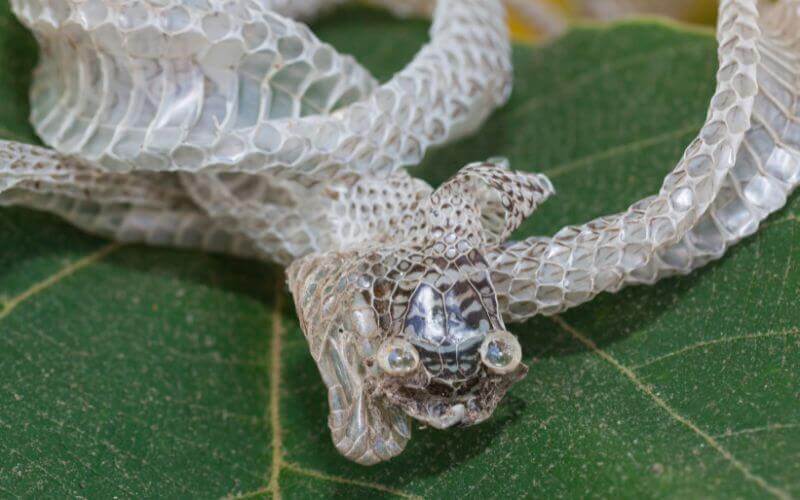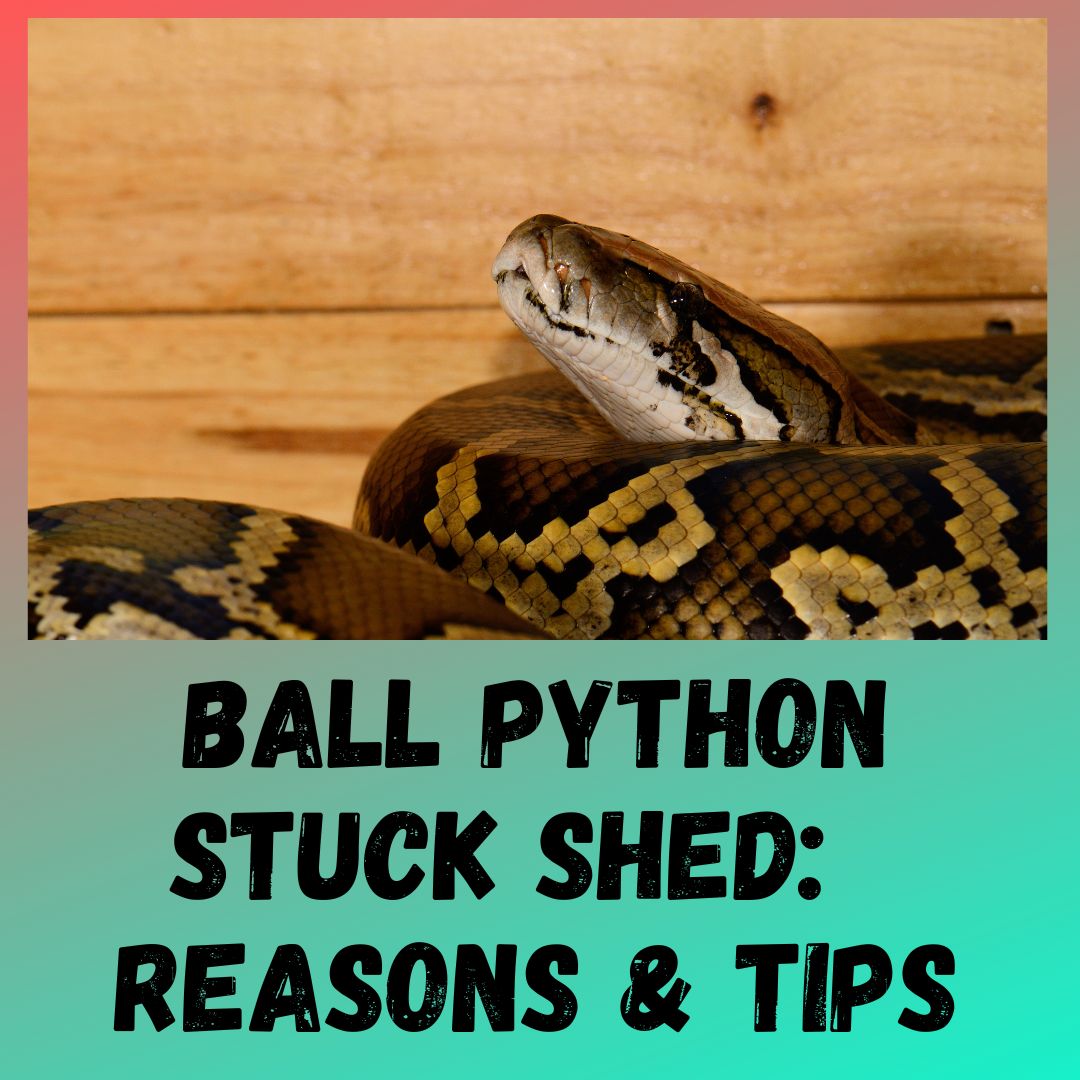Skin shedding is mandatory for all snakes throughout their lives. Every snake sheds its skin throughout the entirety of its life. Even though it’s usually a normal process, problems can come up that a snake owner needs to know. Any new ball python keeper might worry about a shed that won’t move.
Post Contents
- Why Do Ball Python Get Stuck When Shedding?
- Can a Stuck Shed Hurt a Ball Python?
- The Shedding Process
- Soaking Your Balls Python In Warm Water
- Ball Python Sauna
- Why Do Ball Pythons Look More Attractive After They Shed?
- How to Handle a Stressed Ball Python
- Can You Feed a Ball Python When It Is Shedding?
- Summing Up
Why Do Ball Python Get Stuck When Shedding?
Ball pythons suffer from stuck sheds as a result of dehydration caused by poor husbandry. For a ball python to get the appropriate condition to shed appropriately, the humidity should be around 55%. Any humidity lower than 55% may cause dehydration which will result in a stuck shed.
The humidity level can be measured using a hygrometer. Check this hygrometer on Amazon.
Can a Stuck Shed Hurt a Ball Python?
Stuck sheds are typical in ball pythons. Typically, the skin will tear at some point around the python’s body, which permits some sections of it to fall off. However, the other section of the skin will remain linked to the snake.
Skin that attaches to the main area of your snake’s body usually is not an emergency condition. Often, the snake will get rid of the retained skin during the next shed cycle.
However, it usually is good to try removing the remaining skin when possible to help decrease the possibility of infections or other skin problems.
The Shedding Process
The shedding process is relatively predictable in its progression.
First Stage of Shedding
You’ll probably notice that your snake’s skin looks a bit duller than usual, and his eyes may become blue. Snake keepers refer to this stage as “in the blue”.
This is caused by a layer of fluid that accumulates between the outermost layer of your snake’s skin and the layer directly beneath it. This liquid will facilitate the removal of the old skin.
This process phase typically lasts between 5 and 7 days; however, this varies. Your ball python may be more secretive than usual during this time.
During this time, he frequently refuses food and may be more defensive or anxious than usual.
Typically, when shedding time approaches, you’ll notice that your snake’s eyes (and, to a lesser extent, his body skin) will get somewhat more transparent. You will likely observe your snake crawling around its enclosure two days later.
Second Stage of Shedding

You may observe him rubbing his nose against objects in his surroundings. He is doing this to assist in removing the outer (old) layer of skin near his lips, so initiating the shedding process.
Once the outer layer on his face begins to flake off, he will start to shed the old skin.
He may weave his body through any nearby climbing branches or around his water bowl to provide the friction required for the operation. The duration of the procedure can range from 10 minutes to several hours.
The snake will typically regain his appetite and temperament upon completing the shedding process. In addition, his coloring will ordinarily be vivid and vivid.
If your ball python is shedding in pieces or observing a shed that has been trapped, you may need to provide some further assistance.
Here are the commonly used techniques to assist your ball python in shedding.
Soaking Your Balls Python In Warm Water
When experiencing a shed for the first time, it is typical for others to recommend soaking the ball python in warm water.
By their natural behavior, ball pythons would not sit in bodies of water but would instead dig a tunnel that preserves humidity.
Aside from normal behavior, soaking your ball python should not be necessary. Ball pythons require a consistent humidity of at least 55 percent, which may be measured using a digital hygrometer.
If the humidity drops any further, the snake could get dehydrated. Dehydration, soaking in a water bowl, and a jammed shed are indications of improper husbandry that must be handled immediately.
Furthermore, placing an animal in a body of water can be pretty traumatic.
Rather than leaving your snake in a frightening scenario, creating a Snake Sauna that boosts the humidity level to remove the clinging without putting it in danger is preferable.
Ball Python Sauna
Suggesting a ball python sauna does not necessarily mean that the soaking technique is incorrect. However, This method is known to be more effective compared to soaking.
That isn’t to say soaking a snake in water is erroneous or harmful, but this technique is more effective at removing stuck and minimizing the chances of your ball python having stress.
Requirements
- A home storage bin that has a locking lid and no air circulation holes
- Your favorite water-holding substrate or Coco husk chips
- A waterproof digital thermometer
- The water of about 90-95 degrees
- A big towel
Steps
- Take your storage tub and ensure it is clean inside. A tub without air ventilation is advisable to confirm the humidity is trapped. Ball pythons are said to have a low respiratory rate. This means it is doubtful for them to suffocate in a lidded bin.
- Put a coconut chip of about 1-2 inches at the bottom of the tub. Make sure it is moist before you put it in.
- Next, take your warm water. Ensure the water is 90-95 degrees. Use a thermometer to measure to ensure it is not too hot. Fill the coconut chip halfway with the warm water and immediately put the lid on the lidded bin.
- Take your ball python, place it in the lidded bin, and cover it immediately with the lid.
- After that, gently put a towel to cover the top. This condition acts as an assurance of security for your snake.
- The snake should stay in there for around 15-20 minutes. The snake moves around the coconut chip rubbing itself against it and removing most of its stuck shed, if not all.
- After the required duration, take the towel off. The water would have formed fog due to the high humidity. That is great because it means your sauna worked.
- The next thing now is to check on your snake. The stuck shed should have been pulled off. If not, it may be advisable to add some water and repeat the process for another 10 minutes.
Why Do Ball Pythons Look More Attractive After They Shed?
Over time, the outside layer of your ball python’s skin becomes encrusted with dirt, dust, and debris. The scales might also become scraped by your snake’s usual daily activities. Both of these conditions can cause the colors of your snake to fade over time.
However, as your ball python sheds, these dirty and damaged scales are expelled, revealing the brightly colored, new, and pristine scales beneath. This improves the appearance of newly shed ball pythons and most other snakes.
How to Handle a Stressed Ball Python
Sometimes the ball python might develop stress due to stuck shedding. All you need to do is drape the agitated snake with a towel at such a time.
It helps the snake calm down, allowing the owner to pick it up with the towel and transport it to its desired location.
This is an effective strategy if you need to clean the snake’s enclosure while it is agitated or if the snake needs a vet visit but is unwilling to cooperate.
If it is not necessary to handle them when they are restless, leave them alone and allow them to settle down.
Daytime is the optimum time to handle and interact with your ball python. They are more active and alert at night when they are less tolerant of being held.
It, however, varies from snake to snake, as each has its personality and peculiarities. Some snakes enjoy being kept regardless of the day, but others do not.
Can You Feed a Ball Python When It Is Shedding?
There is no compelling reason for experienced keepers to feed their ball pythons throughout their shed cycles.
In addition, because it might cause issues, novices would be advised to wait to feed their snake again until he has shed entirely.
How to Feed Your Ball Python During and After Stuck Shedding
Weekly, provide your ball python with a suitable-sized rodent. Prey objects “appropriately sized” are no more significant in circumference than the ball python at its greatest circumference.
Young ball pythons can consume rats, beginning with rat pups or “crawlers” and progressing to more giant rats as they mature.
After feeding, handling your ball python will only result in regurgitation therefore do not handle it. You can feed ball pythons with frozen or dead rats.
It is not advisable to leave your ball python with a rodent as they may cause injury. Ball pythons are notorious for not feeding at various periods of the year, especially during the winter.
Be prepared for your ball python’s potential to stop eating, and keep a close eye on the snake’s general health and weight.
This situation usually is not a cause for concern with well-established, healthy pythons, but it can be annoying for the snake keeper.
If your ball python is healthy, proceed with your regular care routine, but limit the amount of handling.
Ball Python Feeding Periods
Every 10-14 weeks offer food to your ball python till it regains an appetite and resumes normal feeding.
The adult ball pythons should be fed every 1- 2 weeks, whereas the owner should feed younger ones weekly because they require this energy to grow.
During the cooler, drier months of the year, it is normal for captive ball pythons to stop feeding. Generally, snakes do not consume food throughout the shed cycle.
Summing Up
Stuck shedding can be the most stressful time of owning a ball python. However, with skills on how to help it to pill its stuck shed off and maintain it, it can be effortless.
The sauna method is the most advisable method for helping your ball python pill off its stuck shed.
Just be sure to watch your snake frequently so that you can detect when he is commencing his shedding cycle and make any required adjustments to his care to ensure problem-free shedding.
Fortunately, ball pythons are not very susceptible to shedding issues, and many keepers will be able to prevent them.

94% of pet owners say their animal pal makes them smile more than once a day. In 2007, I realized that I was made for saving Animals. My father is a Vet, and I think every pet deserves one. I started this blog, “InPetCare”, in 2019 with my father to enlighten a wider audience.
